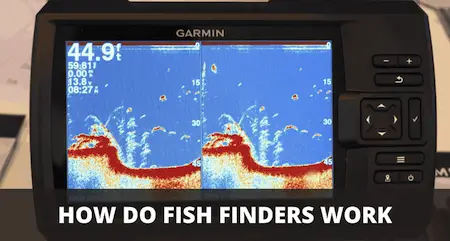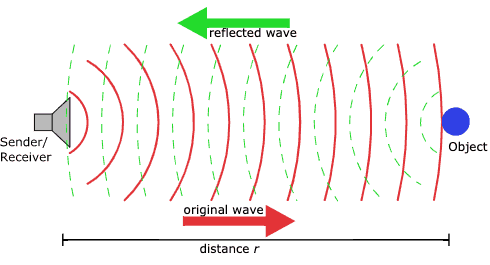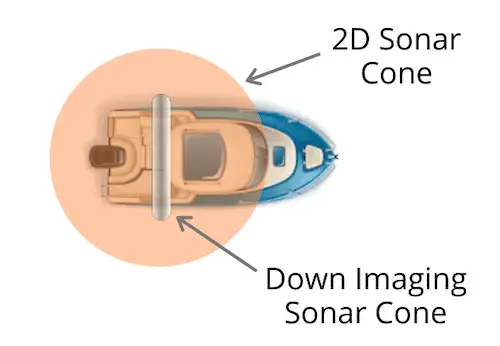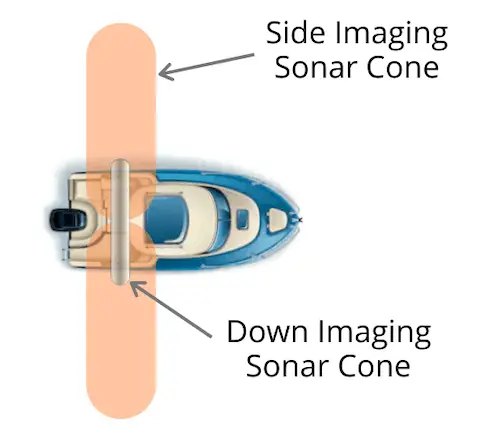How Do Fish Finders Work? (Explained For Beginners)
UPDATED 17 MAY 2023
by Robert Ceran
Are you wondering, how does a fish finder work? If yes, then you’ve come to the right place, as we’ll answer that question in full detail.
A fish finder is a device that uses sonar technology to identify fish and other objects underwater.
Fish finders usually have a color screen that displays the signals received by the fish finder, and these signals can be used by a skillful angler to locate and catch fish.
Modern fish finders can also be used to gather a lot of additional information, including depth and temperature of the water, as well as bottom consistency, and even GPS coordinates.

In this article we’ll cover the details of how a fish finder works, and how you can use it to find and catch more fish.
How does a fish finder work?
A fish finder consists of two main parts – the transducer element and the main processor plus display. The latter is basically a small computer that processes information received from the transducer, and transforms it into digital signals on a screen.
The transducer contains piezoelectric crystals that are used to send sonar pulses down into the water by vibrating at a specific frequency. When these pulses encounter an object, they are reflected back to the transducer, which receives the signals, and passes them on to the main unit for interpretation.

Principle of sonar signaling (Source: Georg Wiora, CC BY-SA)
Based on the intensity of the returning signal, as well as the time it takes to travel through the water, the fish finder can calculate the shape and location of the objects that reflect the sonar pulse. This process is repeated several dozen times per second, which helps to improve resolution, and to generate a live image of what is happening in the sonar cone.
The details that can be interpreted from sonar signals also depend on the power and the frequency of the pulses. Because of this, many fish finders use several different frequencies at the same time to gather more information (called CHIRP sonar, see below for more details).
One question I get very often is, “can you use a fish finder out of water?” In brief, the answer is no – it only works in water.
However, you may be surprised to learn that you can use a fish finder to shoot sonar through ice, since ice readily propagates sonar signals.
Types of fish finders & how they work
In order to understand the details of how a fish finder works, it’s important to know that fish finders make use of three different basic types of sonar technology:
- 2D sonar
- Down imaging sonar
- Side imaging sonar
Now let’s take a closer look at each of these categories.
2D sonar vs down imaging sonar
Traditional fish finders rely on 2D sonar (which includes CHIRP sonar), while the latest generation of fish finders rely on down imaging sonar.
The transducers of traditional 2D sonar fish finders are round in shape, and as a result they emit a sonar signal that widens into a round cone as it travels downwards through the water. Because of this, they gather sonar information from a quite wide circular area below the boat.
Down imaging sonars, on the other hand, use a thin rectangular transducer that sends a narrow sonar beam straight down into the water. As a result, down imaging reveals highly detailed information gathered from a narrow cross section right below the boat.

Each type of sonar has its own advantages and disadvantages:
- 2D sonar can be great for scanning the area below your to locate game fish, which show up as arches on the screen. However, very often the outlines of objects on the screen are ‘fuzzy’ and indistinct, which makes it hard to identify details. For example, a school of bait fish usually shows up as a large blob on a traditional 2D sonar fish finder, though CHIRP has really improved performance in this regard.
- Down imaging sonar is great at revealing objects as discrete structures, including game fish that are resting on the bottom (which can’t really be detected with 2D sonar), or individual fish inside a tight school of bait fish. The disadvantage of this type of sonar is that it only captures a very narrow section of what’s directly underneath the boat, while missing anything that’s a little further away.
Down imaging vs. side imaging
As the name suggests, down imaging is focused directly downwards in a narrow section, while side imaging sends out signals directed towards the sides (both left and right). This helps to gather information about the more general area surrounding the boat.

Again, each of these types of sonar has its own advantages and disadvantages:
- Side imaging is great for getting an overview of a large area surrounding your boat on either side. You can quickly spot prominent structures, such as boulders, sunken trees, and weed beds, and you can also determine bottom consistency. However, it’s not very good at identifying smaller objects such as fish.
- As already mentioned, down imaging is perfect for getting fine grained info about what’s directly underneath the boat, while it doesn’t give a general overview of the area.
| Advantages | Disadvantages | |
|---|---|---|
| Traditional 2D sonar | Great for spotting game fish close to the boat as arches on the display | Low object separation & cluttered screen due to wide sonar cone |
| Side Imaging sonar | Great for scanning large areas around your boat | Low amount of detail, making it hard to spot fish |
| Down Imaging sonar | Great for getting the most detailed information about everything right under your boat | Narrow focus doesn’t let you get an overview of the area around your boat |
Table 1: Advantages and disadvantages of 2D sonar, side imaging, and down imaging compared.
As you can see, none of these sonar technologies is perfect on its own. Instead, they are best used in combination, which is why many modern fish finders include all three types of sonar technology.
Once you learn how to use each type of sonar on its own, you can then switch back and forth between them to get the maximum amount of information.
Check out our detailed guide on how to read a fish finder to improve your skills in this area.
What is CHIRP on a fish finder?
CHIRP sonar technology is relatively new, and stands for Compressed High Intensity Radar Pulse. While traditional 2D sonars only utilize one frequency, CHIRP sonar uses a range of different frequencies, sending both low frequency and high frequency signals in bursts.
If you’re interested to learn more about CHIRP, check out our article on how to read CHIRP sonar.
Fish finder batteries
Since fish finders use electrical signals and transform them into sonar pulses that are sent into the water, they depend on having a sufficiently charged battery to power them at all times.
For more details on this, take a look at our review on the best battery for fish finder.
Fish finders with GPS
Many modern fish finder models incorporate GPS functionality, which really helps to improve performance. For one thing, this allows you to navigate to specific points on a map. But even better than that, it allows you to place a GPS marker on specific locations that you want to use as points of reference. This could be a reef, for example, or a large underwater structure such as a wreck, or areas where there is a transition in bottom consistency, which often attract fish.
Some of the high end models use GPS together with a chartplotter. That way you can create a custom map of the waters while you explore them, which will enable you to return to the top locations quickly and easily in future.
The two best mapping softwares currently available are Navionics and LakeMaster. If you want to learn more about them, check out our article on Lakemaster vs Navionics – which is better?
Types of transducers & how they work
While many fish finder models are sold together with a transducer, they can also be purchased separately, and it’s possible to use a fish finder with several different kinds of transducers.
Different transducers operate at different frequencies, which means you have to choose the correct frequency for your specific application. For freshwater sport fishing, the frequencies range from 50 kHz to 300 kHz, with 200kHz being the most common.
Also, you should be aware that traditional 2D sonar transducers are different from CHIRP transducers. So, if you want to use CHIRP, make sure to buy a CHIRP ready transducer that covers the frequencies you want to use, which would be 150-200 kHz for most freshwater applications.
If you’ve got a transducer, but you’re not sure if it’s working properly, take a look at our article on how to tell if your transducer is defective.
Transducer mounting style
Different types of transducer require different mounting styles:
In-hull: some transducers don’t need to be in direct contact with water, since they can transmit sonar through the hull. They can be glued to the inside of the hull. However, they don’t work with all types of hull, so make sure to check that before you buy.
Transom-mount: this is he most common type of transducer mount, and relies on an adjustable bracket attached to the outside of the hull at the back end of the boat or kayak. With this kind of mount, the transducer inserts into the water.
Trolling motor mount: some transducers can be attached to the side of a trolling motor, or even inserted into the propeller hub, which also allows them to insert into the water.
Conclusion
This concludes our article on how does a fish finder work. To sum up, fish finder technology has come a long way over the past decades.
The top quality models now combine CHIRP sonar, down imaging, side imaging, plus GPS, and this combination of high quality technology enables skilled anglers to find promising fishing locations rapidly and easily, when in the past they would have spent days or weeks trying to find them more or less by accident.
If you’re thinking about purchasing a new fish finder, take a look at our review of the the top fish finders under $300.
Finally, if you’re into ice fishing, you might be interested in our review on the best ice fishing flasher.
